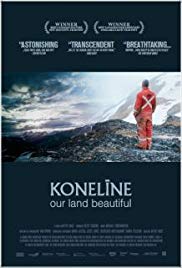highlights industry and how it threatens to change our lands, with a focus on how this will affect some of our people. It also
focuses on several settlers and visitors to our lands. As the artist, she chose the colours – the voices – to paint the canvas, to narrate a perspective. Our Tahltan eyes focus on how our relationship with the land is being fractured due to colonization and the need for jobs, and how our people may be perceived through the footage chosen. As humans, everything we encounter is filtered through our lived experiences. Because of this, we feel that the story told through the lens of non- Tahltan people has not been helpful to Indigenous-settler relations. The film poorly portrays Tahltan people on our territory. An example of this is the juxtaposition of the Tahltan hunters and the settler hunters. The Tahltan hunters use high-powered rifles and drive a pickup truck. The settler hunters visiting our lands carry bows and arrows and are shown walking in the pristine wilderness while talking
about being one with nature. This is reminiscent of the “pizza test,” a term used during the Delgamuukw
court case in northern British Columbia. The lawyer for the Crown argued that if Indigenous peoples ate contemporary foods, such as pizza, as opposed to eating only traditional Indigenous foods, then this not only extinguished their Aboriginal rights but also negated their “Indian” authenticity – a ridiculous premise. Using this unfair test, the settler hunters may appear to be more Indigenous than our hunters. Having said this, we have to be careful not to fall into the trap of feeling obliged to explain our people’s actions and situations to outsiders. This film focused on many settlers and visitors to our lands. Big-game outfitting in British Columbia is a lucrative business, and our people have a long history of guiding outsiders who have come into our lands, showing them where and what to hunt. In terms of how industry is affecting outfitters’ livelihoods, the settler outfitter spoke
about how it is driving the animals away, but her focus was on how this was bad for business. Our focus is on how it disrupts
our people’s lives as well as the lives of the animals with whom we share the land. It is a tough situation our people are in, needing to survive by making money to live and support our families. Because of colonization, we often have to turn our backs on our ancestors’ teachings about protecting the land, about nurturing our relationship with it and with all those with whom we share it.
Wild ’s film demonstrates that settlers have a long way to go in understanding colonization, both past and present. Canada was founded on the appropriation of our lands and our ways of life. In order for reconciliation to occur, settlers need to relinquish the desire to speak for us; they need to become allies as we strive to make room to tell our stories with our own voices. Ts’msyen scholar Charles Menzies (2016) says that, when carrying out research with Indigenous peoples, non-Indigenous researchers need to step back, turn their gaze, and follow rather than direct – advice non-Indigenous filmmakers need to respect and abide by.
References
Menzies, Charles.2016. People of the Saltwater: An Ethnography of Git lax m’oon.
Lincoln: University of Nebraska Press.
 As the language and culture director for the Tahltan Nation and a Tahltan academic, I believe giving voice to our people is crucial.
As the language and culture director for the Tahltan Nation and a Tahltan academic, I believe giving voice to our people is crucial. As the language and culture director for the Tahltan Nation and a Tahltan academic, I believe giving voice to our people is crucial.
As the language and culture director for the Tahltan Nation and a Tahltan academic, I believe giving voice to our people is crucial.